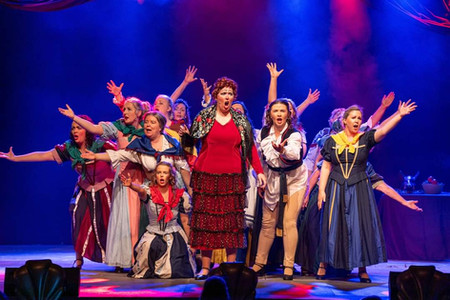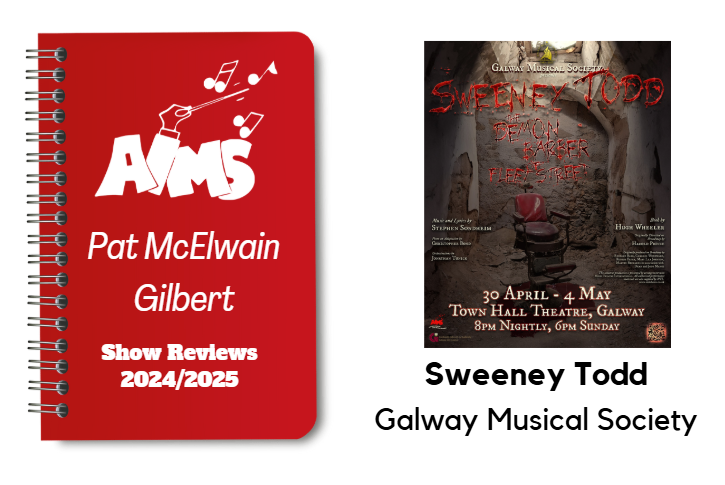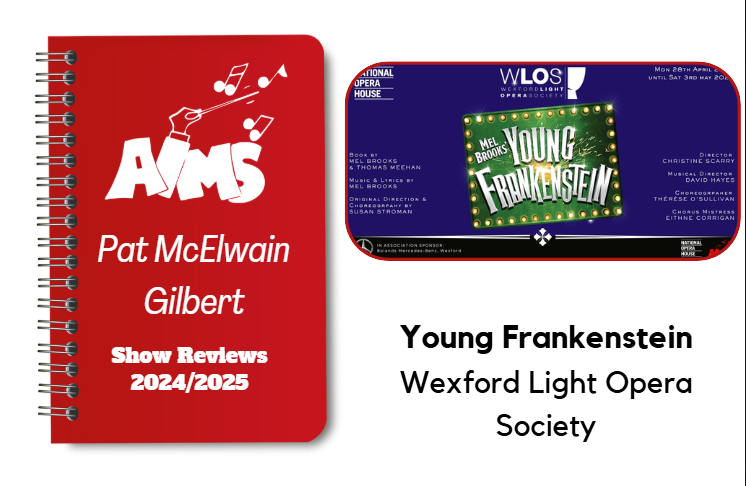Phantom of the Opera as Presented by Ballinrobe Musical Society
- Darragh Carroll

- Mar 25, 2024
- 6 min read

Phantom of The Opera as performed by Ballinrobe Musical Society
Date of Adjudicated Performance: Saturday, 17th February 2024.
Having never seen Phantom of the Opera on the professional stage, it was with much anticipation that I headed to Ballinrobe, humming Music of the Night and All I Ask of You, and expecting something fabulously moving and technically dynamic. I didn’t leave disappointed. Much praise must be heaped upon Director, Alan Greaney, for taking this complicated piece and presenting it with such a high level of achievement in a venue that requires vision and imagination to facilitate anything approaching the level of technical wizardry required for this show. The thought that went into the set and the lighting, the chandelier, the boat, the dry ice, the magic mirror, and the dressing of the hall as an Opera House was remarkably good.

A gilt framed proscenium arch, golden columns, and wonderful golden, lushly decorated, private boxes either side, was the sight that greeted the audience upon entering the auditorium, instantly making a strong impact on the senses. Clam-shell footlights along the front of the stage added period and character to the setting. A wonderful chandelier at ground level for the opening auction scene, and then rose majestically into the flies. The stage R, box rotated inwards to present a wonderful balconied house interior, and hidden behind the stage L box, an expertly constructed pipe organ, dominating the entire corner of the stage. In the background were well-painted representations of the Paris Opera House, both interior and exterior, and an effective grave yard. There was so much to commend this set and its visual impact, including well-used flash/smoke pods, and the haunting first appearance of the Phantom to Christine in the mirror of her dressing room. Likewise, the apparition of Christine’s reflection, in wedding dress, in the sewer scene, was most effective. There were so many moving pieces to the set that I can only highly praise the stage crew, under stage manager, Ken McCarthy, for keeping it running so smoothly.
It really was quite sumptuous as sets go, and with good lighting, most of the scenes had great atmosphere. The sewers, in particular, combined dry-ice, haunting green back-light, and rows of candles lighting the path of the boat/gondola that carried the Phantom and Christine. I’m reluctant to mention the scene where poor Christine was in partial shadow for a while, due to some props being too far off-stage, for it was a minor blip in a technical display that really was quite outstanding.
There was a problem with the pace of the show, on several occasions, when perhaps the incidental music needed to be accelerated to diminish the long phrases of inactivity between Christine and the Phantom. I did also feel that some solos were taken at too leisurely a pace, particularly Music of the Night and All I Ask of You, stretching the singers to almost run short of breath. Musical Director, Finola Higgins, had a very fine 13-piece orchestra to bring to life the beautiful musical score, and they played with good accuracy and energy, even if on occasions a bit more attack was needed. Vocally, it was evident that much work had been done on preparing the chorus, who performed with good strength and precise harmonies. The choral section of the Don Juan Opera sequence is vocally challenging, and was handled with a measure of success. Finola was blessed to have very secure singers in the principal roles.
Niall Conway’s acting, in the role of The Phantom, was at its best in those scenes when he was unmasked and vulnerable, and when he was overtaken by anger and outrage. This is when his strength and stature were most effective, and when he was able to use his powerful voice as a weapon. Niall has amazing vocal versatility, and while everything was well-sung, there were occasions, particularly during the duet scenes with Christine, when a tendency to err physically towards a kind of melodramatic gentility, seemed to weaken his character. I think, perhaps, this was highlighted by the lack of pace during some of these exchanges. His make-up was a work of art, and I truly felt moved by his discomfort at being exposed.
There was a delightful delicacy about Eve Garavan in the role of Christine, which suited the vulnerability of her character, but it was a sublime quality of voice and diction that really stood out, making this a superbly exquisite vocal performance, with The Phantom of the Opera and Wishing You Were Somewhere Here Again being exceptionally beautiful. There was so much sincerity in this emotional performance.
Edward Scott’s performance as Raoul was honest and true, and wanted only for a bit more confidence and stage-presence, which will undoubtedly come with a few outings on the boards. He gave a good vocal display, with a beautiful duet in All I Ask Of You, and his acting was very credible.
Catherine Conway was a revelation in the comedic Diva role of Carlotta Guidicelli, vocally drifting effortlessly through her range, from coloratura to lyrical to dramatic soprano. In a role that could have been written for her, she also amazed with excellent comedy timing and delivery, a fabulous look, and superb facial expression.
Providing much of the shows light relief were Richard Crumlish as Gilles André and John Byrne as Richard Firmin, the rather farcical gentlemen who take ownership of the ill-fated Opera Populaire. Both of these performers proved how gifted they are as character/comedy players and also possessed the vocal quality to partake in the tricky harmonies of Notes/Prima Donna and Notes/Twisted Every Way.
Angela Staunton had a dark and somber countenance as Madame Giry, the ballet-mistress and go-between from the Phantom to Christine. She kept her character very well throughout the story, like a haunting presence, and delivered strong vocals in her several musical pieces. I’m not sure I understand at all what is the point of the character Meg Giry, Madame Giry’s daughter, but regardless of that, the role was played delightfully and confidently by Kate MacDonnell, making the most of her few lines and contributing to the Opera House scenes with very good vocal quality.
Joff Manning had the perfect stature for the somewhat pompous and self-adoring operatic tenor, Ubaldo Piangi, and played the role with a suitable, well-gauged sense of comedy, even if the tenor line was a tad strained for him to sing comfortably, and Michael Cooney completed the principal line, with a convincingly slovenly, couldn’t-care-less attitude towards the Opera elite, as a rather good Buquet.
Uncredited in the program were the three ladies of the court who made a very worthy contribution to one of the opera scenes, and despite my familiarity with this company, so effective were their exaggerated make-up and wigs that I am unable to mention them by name. They were, however, very impressive.
Similarly, there was a fine contribution from company stalwart, Gerry Hughes, as the chief of the somewhat geriatric unit of the Paris Gendarmerie. Their slightly bumbling approach to security was a nice comedic touch. Tidy cameo performances were also turned in by Pat McGovern as the retiring owner of the Opera Populaire, and by Mick Sweeney as the director of the Opera.
The show is light on chorus work, except that they do have those rather tricky choral pieces during the Don Juan Opera. They achieved these with a good level of success, and were vocally strong and accurate in Masquerade and other pieces. With their movement, dance and general involvement, they did everything that was asked of them with energy and enthusiasm. Several chorus members also successfully filled cameo roles, and I loved the troop of Gendarmes.
Choreographer, Aoife McClafferty, was caught a little between a rock and a hard place, wanting to employ the chorus as often as possible but having so few opportunities to do so. I think this lead to the Masquerade number suffering a bit from being over-crowded. It did however have a most beautiful section when the entire chorus danced illuminated only by hand held, mock-candle-light. The effect was quite stunning. Aoife also did a good job on the Opera sequences in Act One, including some very nice ballet pointe work and well-patterned routines.
From a visual point of view, the make-up used for the Phantom was exceptional. There was an audible gasp when his mask was first removed, and when his wig came off to reveal a severely disfigured skull, complete with wispy hair and grotesque growths, it was quite disturbing. Excellent make-up was also used on Carlotta to establish her pomposity, and similarly with the three ladies of the court. Wigs were well-worn and make-up generally was of a high standard. Costumes, likewise, were consistently good and appropriate to each scene and each character, with good distinction between the everyday costumes and those used in the Operas.
With a beautifully dressed foyer and a most attentive front of house staff, the audience were lulled into the mood and ambiance of the show before they even stepped into the auditorium, and I can bear witness to the compliments that were flowing, regarding the production, as they exited the theatre, so congratulations to one and all for such a fine achievement.
Peter Kennedy
Gilbert Adjudicator 2023 / 2024
Some photos kindly shared by the society - Photos by White Thorn Media












Comments